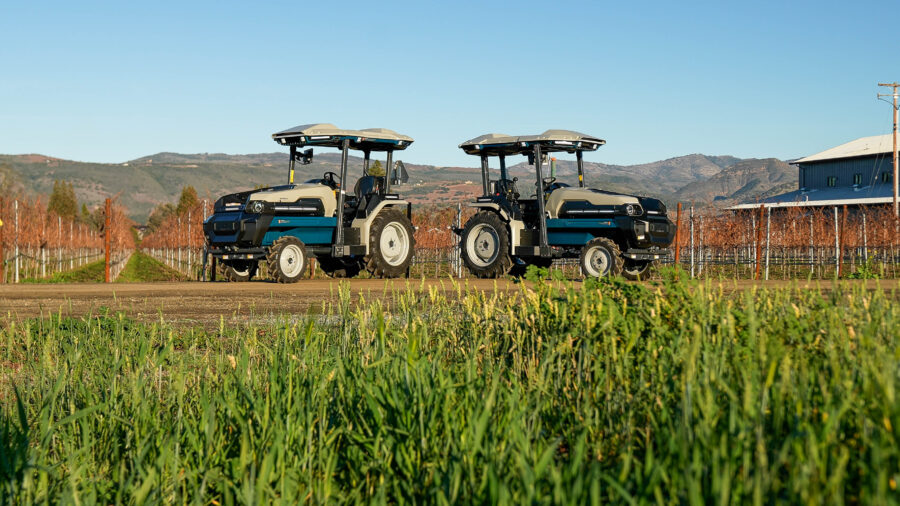In May, CNBC revealed its annual Disruptor 50 list, a who’s who of “private companies that are chasing some of the market’s biggest opportunities.” Thirty-five were industry unicorns with market valuations of $1 billion or more, and 12 were valued at over $10 billion. The 50 companies selected account for over $54 billion in venture capital with a total estimated net value of over $362 billion.
OpenAI paced the list, followed by Brex (“a better Silicon Valley banker”) and Canva, the ubiquitous design and graphics platform. Scroll down, though, and a company named Monarch Tractor is #49 (“EV farming”). As Tesla and other vehicle manufacturers inch toward a safer future of autonomous vehicles, agritech presents a unique opportunity for those interested in self-driving, “smart” implements – whatever that means – due to its unique limitations. No roads to speak of; no concrete barriers to plow through; most importantly, no or extremely limited exposure to other people, meaning similar technological principles that power a Roomba around the living room may apply to a million-dollar tractor around the harvested hectares.
Tomorrow’s Farm is Efficient, Data-Driven, and Renewable
Farming is one of the oldest, most demanding, least compromising, and generally low ROI industries the world over. For centuries, farmers have struggled with how to get the most out of their beasts of burden, their implements, their teams, and their crops and harvest. Feed is expensive. Fuel is expensive. Everything is expensive.
Wide-scale adoption of the electric vehicle (and its ensuant electrical infrastructure) is coming to America’s roadways and a similar revolution may be at hand for the rolling fields and amber waves of grain for the farms and farmers of America and the world.
“Farmers’ margins are decreasing as food costs, machinery costs, labor, land costs, and inflation are all increasing,” says Nathan Garner, a farmer himself and owner of Garner Farms. “The only way that [farming works] is by becoming more efficient; technology has allowed that. GPS systems drive tractors with advanced planters that get more consistent and uniform crops. Drones and satellite imagery can detect problems before the naked eye can detect them. Irrigation systems and the water pumps feeding these systems can be controlled with accurate cell phone apps. The harvesters can be dialed in with the touch of a button to minimize losses and increase yields.”
As futuristic farm technology becomes more affordable, scalable, and (most importantly) reliable, traditional modes and operations of the farm are evolving with each passing year.
“Customer interest and perception of electrification and autonomy are changing,” said Praveen Penmetsa, CEO of Monarch Tractor, to The Food Institute. “Farmers want a solution that is compatible with their existing farm ecosystem and promises clear payback.
“From the response we’ve received across the U.S. and beyond, farmers are willing to adopt electrification and are beginning to find more reasons to invest in solar and renewable energy on the farm now that they have a fleet of electric tractors,” Penmetsa continued. “A fleet of electric tractors enables faster payback for renewables, creates energy storage opportunities, and promotes energy independence for farmers.
“Simultaneously, the industry is shifting – now, we are seeing almost every major OEM working on electric, autonomous ag equipment. The difference is that we have gone to market and have a commercially available tractor, while others are still in product development.”
Monarch tractors use the J-1772 charging standard, the most common charger type for electric and hybrid vehicles, meaning any farm with a standard 240V outlet – every farm, in other words – can handle a Monarch alongside the usual coterie of air compressors, welders, and other heavier-duty pieces of garage/utility/barn equipment.
As range anxiety continues to deter consumers from embracing electric vehicles on a larger scale, farmers endure the same reservations, though at much larger import – their vehicles aren’t just for mobility, after all. Their vehicles are their livelihoods.
“One of the biggest concerns from farmers is the amount of investment they’d need to implement an electric, autonomous tractor,” Penmetsa said. “We had to create a clear guarantee that farmers saw a quick ROI and added value from the MK-V [Monarch’s latest model], such as the many benefits of combining EV, autonomy, and digital data to optimize operations and add profitability.
“Farmers were skeptical about charging downtime for electric machinery,” he added. “To circumvent this, we developed an industry-leading battery capable of 14 hours + operating hours (depending on the farm, operation, and implement). We also ensured that the battery had a quick charging time of 5-6 hours with an 80-amp charger.”
The Most Valuable Contemporary Resource
Range anxiety aside, autonomous/electric tractors and hypermodern implements offer more than just renewable energy savings in the field; they provide a resource more valuable than any sold at market: data.
“For farmers, one benefit of autonomous tractors is data collection without the burden of extra time or effort,” said Ben Adolph, founder and CEO at Merge Impact, a blockchain-powered agricultural measurement and data solutions company, to The Food Institute. “These computers can amass extensive information about soil, land and farming practices, providing measurements of sustainability efforts (biodiversity, carbon, water usage). These baseline numbers enable farmers to make decisions about specific, strategic improvements that raise their bottom line.”
Farmers are, by necessity and vocation, an ecologically conscious labor force. And with contemporary smart vehicles, there’s an ecological/economic feedback loop that trickles down to today’s consumer. “Food brands sourcing from these farmers will be armed with verifiable, secure, and transparent data,” Adolph mused, “allowing them to market sustainability claims and win over consumers looking to support the fight against climate change with their food purchases.”
Penmetsa estimates that some of its operators in California are saving nearly $80,000 per year in diesel fuel costs alone. Labor savings are much more significant – he estimates at 50% automation, farmers can save upwards of $100,000, and the scale increases with the deployment of more automated vehicles (he estimates 85% automation yields approximately $200,000 in labor savings). The MK-V Monarch can also reduce 50 metric tons of CO2e per tractor, or the number of metric tons of CO2 emissions with the same global warming potential as one metric ton of another greenhouse gas.
“Precision farming uses data analytics, predictive modeling and technology to optimize the food manufacturing process from field to fork. Precision farming enables farmers to analyze soil quality, weather patterns, and crop performance to determine the precise amount of water, nutrients, and pesticides required for each crop. By using precision farming techniques, farmers can improve crop yields while reducing waste, thereby producing more food while conserving resources.”
Steve Dombrowski, Director, Consumer and Food & Beverage Markets at QAD, a supply chain and manufacturing company
Today’s smart implements and robotics can do everything from operate autonomous implements in the field to monitor crucial silo volume and quality data, assess crop health, even analyze crop and animal health. And that’s just scratching the surface.
“The future of farming will be shaped by a variety of emerging trends and technologies,” said Renji John, CEO and founder of Honest AgTech, a sustainable solutions technology company. Like any investment in any sector, caveat emptor applies to the reckless farmer drawn to the technology without running the numbers.
“The returns on technology investments are directly related to where it is on the hype curve,” John said. “It can be different based on the technology and application. For example, autonomous tractors are much further ahead currently in terms of maturity than high-tech greenhouse harvesting robots. If the farmer adopts a technology too early because of inflated expectations, then they are bound to be disappointed with no ROI and even potentially lose their investment in the process.”
Still, automated tractors can do quite a bit, from mowing and tilling to threshing, under-the-vine weeding, and much more, all while collecting data to further hone the long-term process. They can elevate labor productivity and expand a single tractor operator’s role and responsibilities on the farm in an efficient and much safer way.
Reaping the Benefits of High-Tech Farming
Penmetsa is positive the future of farming is near (if not already here). “Autonomous tractors enhance productivity, operational costs and efficiency, and, most importantly, safety,” he said.
“Working from sun-up to sundown, farmers are the backbone of America…Monarch’s purpose is twofold; to elevate farming at an everyday operational level, and to be the catalyst for an industry-level transformation that will create a better farming future. While our smart electric tractor, as a product, has an immediate economic and sustainability impact on farms, it also has the potential to kickstart an industry shift in farming.”
Monarch is far from the only company to recognize the power and significance of what could be a smart farming bellwether for this timeless industry. Treasury Americas is a division of global wine company Treasury Wine Estates with about 7,000 acres of vineyards across coastal California and over 27,000 acres globally.
“We decided that electrifying our transportation and equipment fleet is essential to our energy efficiency and greenhouse gas mitigation efforts,” said Will Drayton, Director of Sustainability and Science for Treasury Americas, to The Food Institute. “By working with this technology, we can create a safer environment for our teams and offer them upskilling opportunities while making progress toward our sustainability goals.”
Treasury Americas is testing Monarch tractors as well, and Drayton says that a major benefit of incorporating remote operation and automation is drastically increased operator safety; smart implements allow the company to remove people from operating on steep slopes or sitting in the tractor cab while spraying. An old adage of farming is the most dangerous place is the seat of the tractor, and these machines enable employers to protect their staff (and for farmers to protect themselves) while catalyzing all their other skills and knowledge – “The machines will work under all conditions, day and night, and we can in turn upskill our employees by tasking them with higher value jobs,” Drayton continued. “The development and growth opportunity for our teams is significant.”
“Some of the most rewarding aspects of this transition is seeing the opportunity it provides for our employees to advance their skills and step into the future of farming.”
Like any market disruption, however, the ultimate testament lies with those with the tool in hand: the farmers.
“The answer is, time will tell,” Garner said. “With time, things get cheaper and they get better. Sometimes we adopt technology because it can better our farm and sometimes we are forced to upgrade out of necessity. Due to a lack of labor or cost of labor, we may be forced to accept autonomous tractors as a way to keep farming. Time will tell.”












